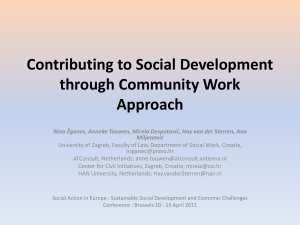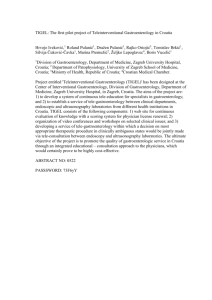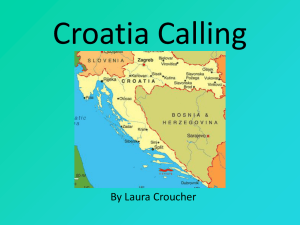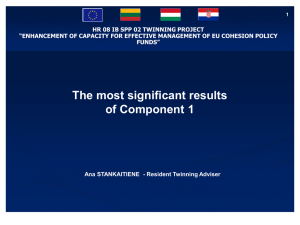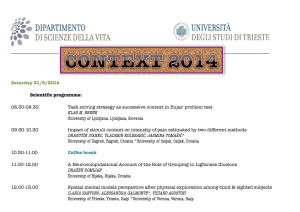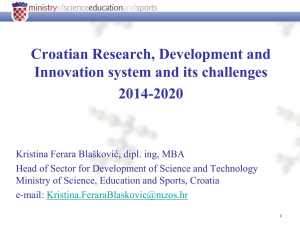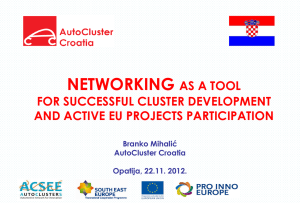paper_53 - Global Sustainable Development: A Challenge for
advertisement
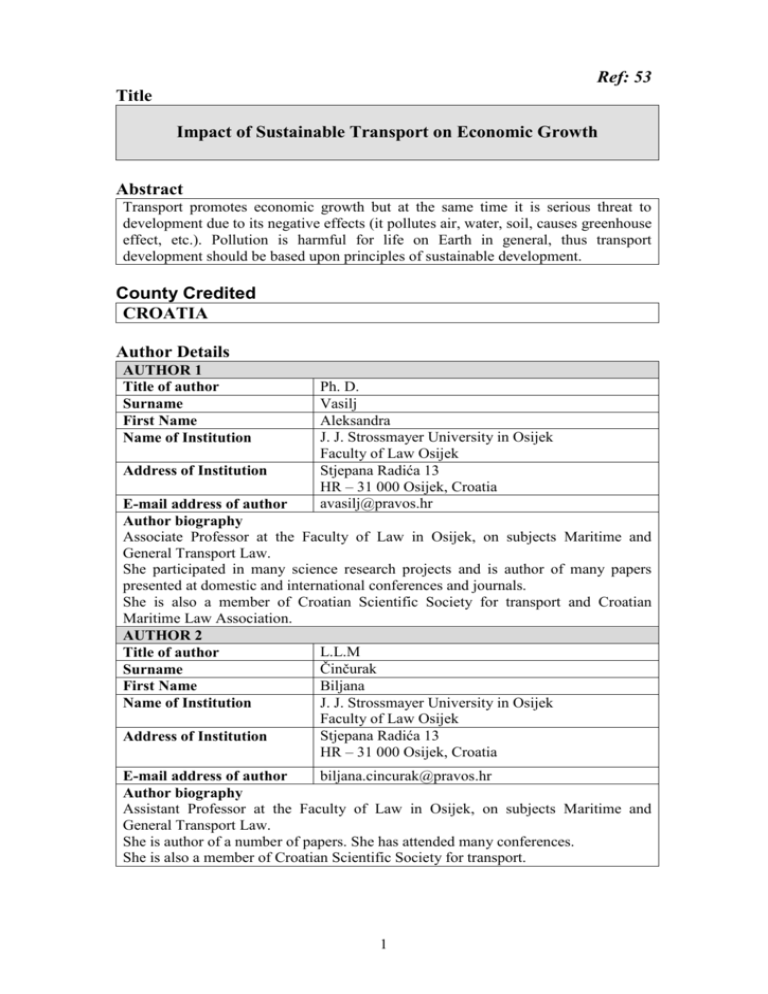
Ref: 53 Title Impact of Sustainable Transport on Economic Growth Abstract Transport promotes economic growth but at the same time it is serious threat to development due to its negative effects (it pollutes air, water, soil, causes greenhouse effect, etc.). Pollution is harmful for life on Earth in general, thus transport development should be based upon principles of sustainable development. County Credited CROATIA Author Details AUTHOR 1 Title of author Surname First Name Name of Institution Address of Institution Ph. D. Vasilj Aleksandra J. J. Strossmayer University in Osijek Faculty of Law Osijek Stjepana Radića 13 HR – 31 000 Osijek, Croatia avasilj@pravos.hr E-mail address of author Author biography Associate Professor at the Faculty of Law in Osijek, on subjects Maritime and General Transport Law. She participated in many science research projects and is author of many papers presented at domestic and international conferences and journals. She is also a member of Croatian Scientific Society for transport and Croatian Maritime Law Association. AUTHOR 2 L.L.M Title of author Činčurak Surname Biljana First Name J. J. Strossmayer University in Osijek Name of Institution Faculty of Law Osijek Stjepana Radića 13 Address of Institution HR – 31 000 Osijek, Croatia biljana.cincurak@pravos.hr E-mail address of author Author biography Assistant Professor at the Faculty of Law in Osijek, on subjects Maritime and General Transport Law. She is author of a number of papers. She has attended many conferences. She is also a member of Croatian Scientific Society for transport. 1 Category Sustainable Development Theme Environment Sustainable Consumption Type of Contribution Research Paper 2 Impact of Sustainable Transport on Economic Growth Aleksandra Vasilj and Biljana Činčurak 1. INTRODUCTION Transport promotes economic growth but at the same time it is serious threat to development due to its negative effects. Transport has a harmful effect on environment since it pollutes air, water, soil, causes greenhouse effect, congestion, acid rain. Furthermore, it increases level of noise and generally has negative impact on environment, health and climate change. Road traffic, especially motor vehicles, is the biggest pollutant of environment. 2. ROAD TRANSPORT –THE MOST POPULAR MODE OF TRANSPORTATION IN SPITE OF HIGH LIVING COSTS Number of motor vehicles is increasing and in turn the consumption of fuel is increasing causing more intensive emission of pollutants in the air. Thus, the road transport is the greatest threat to the environment. Table 1. Registered road motor vehicles in the Republic of Croatia 1998 1999 2000 2001 2002 2003 2004 2005 1 241 522 1 323 653 1 401 010 1 494 745 1 571 775 1 649 851 1 720 119 1 790 971 Source: Statistical Yearbook of the Republic of Croatia, Republic of Croatia Central bureau of statistics, 2006, p. 345. Despite efforts to promote the popularity of other transport modes, especially in congested areas, the car remains the most important personal means of transport. In total transport of goods, share of road transport is also high. Distances between consumers and producers grow, thus more goods are transported over longer distances and more frequently. Road transport is generally faster and more flexible when 3 compared to other modes (especially rail and inland waterways transport), and can therefore adapt much faster to changes in production sites. In addition, road networks are developed much faster than rail networks. Table 2. Structure of transport of passengers and Structure of transport of goods in the Republic of Croatia, 2005 Structure of transport of passengers Structure of transport of goods 13% Road transport 34% 54% 2% 52% Railway transport 27% Air transport 10% Seawater and coastal transport 0,4 % 8% Road transport Railway transport Seawater and coastal transport Inland waterway transport Pipeline transport Source: Statistical Yearbook of the Republic of Croatia, Republic of Croatia Central bureau of statistics, 2006, p. 360. Although, living costs as well as fuel price are increasing, most people can afford a car and thus they do not need to depend on public transport. “This trend is modulated by increasing congestion which constrains the spreading of people, because there is a limit to how much time they will spend on daily transport. But time pressure in two income households means that people favour improvements to the infrastructure, as this will save them time — at least until traffic growth brings motorway traffic to a standstill again. So, there is pressure from both freight transport users and passengers to improve the transport system to allow for more transport.”1 Generally, the main living costs are those for food, non-alcoholic beverages, clothing, housing, energy and transport. Structure of personal consumption in Croatian 1 Transport and environment: on the way to a new common transport policy, European Environment Agency, Copenhagen, 2007, p. 9. 4 households, in year 2005, shows that in total consumption, share of transport is 10.86%.2 "There is a link between economic growth and transport volume growth. Most of the activities that are tabulated and added together to calculate GDP have a transport component. A better transport system is a precondition for a certain type of economic development, and economic development in turn requires more transport."3 Since the mid 90s, Croatia has witnessed a steady growth of GDP and in the period 1995-2006, the average real GDP growth rate amounted to 4.4%. Table 3. GDP per capita in the Republic of Croatia, in US$ 1996 1997 1998 1999 2000 2001 2002 2003 2004 2005 4421,9 4398,2 4850,1 4371,1 4152,6 4476,2 5186,9 6665,7 8029,9 8753,4 Source: Statistical Yearbook of the Republic of Croatia, Republic of Croatia Central bureau of statistics, 2006, p. 196. Due to rising incomes, increasing car ownership and better infrastructure, road transport is going to achieve great development. We should also notice that with rising incomes leisure travel is increasing too, and that is how it also becomes a significant contributor to the increased passenger transport. 3. ROAD TRANSPORT AS AIR POLLUTANT Transport, especially road traffic, has a harmful effect on environment since it pollutes air, water, soil. Furthermore, it increases level of noise and generally has harmful impact on environment, health and climate change. Combustion of fossil fuels causes emission of harmful gases that contribute to the greenhouse effect and acid rain (CO2, CO, CH, NOX, SO2), solid particles (dust, soot, smoke) and metals (Pb, Cu, Zn). 2 Statistical Yearbook of the Republic of Croatia, Republic of Croatia Central bureau of statistics, 2006, p. 191. 3 Transport and environment: on the way to a new common transport policy, European Environment Agency, 2007, p. 10. 5 Table 4. Emission of pollutants by transport mode Pollutant Road transport Railway transport Air transport Maritime and Inland waterways transport CO2 98 1 0.3 0.2 NOx 90.5 4 0.5 5 CH 95 1 1 3 CO2 80 4 11 5 SO2 74 10 2 14 Solid particles 85 5 3 7 Source: J Golubić, Promet i okoliš, Fakultet prometnih znanosti, Zagreb, 1999, p. 17. Table 5. Share of vehicles in pollution of the environment Vehicle Fuel% CO2% NOx% CH% Passenger cars 60 95.9 64.3 80.5 Motorcycles 0.5 1.3 0.1 6.0 Buses 1.9 0.3 2.3 1.9 Goods vehicles 19.6 1.7 28.2 10.1 Railway transport 4.5 0.1 2.1 0.5 Inland waterway transport 1.7 0.2 1.5 0.4 Air transport 6.8 0.5 1.6 0.6 Source: J Golubić, Promet i okoliš, Fakultet prometnih znanosti, Zagreb, 1999, p. 183. 3. 1. AIR QUALITY AND ITS PROTECTION FROM HARMFUL EFFECTS OF ROAD TRAFFIC The general state of environment in Croatia is relatively good, compared to the situation in EU industrial countries. This is mainly because of the low harmful impact of the heavy industries (due to their collapse in the 1990s), and the country benefits from a number of natural advantages such as: unique and relatively well preserved 6 natural environment, high level of biodiversity, high stores of fresh water etc. However, the degree of environmental protection is lower than in other developed countries, primarily due to insufficient investment. The air quality is monitored at local and state level. Croatia has a local air qualitymonitoring network, with measuring stations operating in towns or settlements. A national state air quality monitoring network is being established with 8 monitoring stations in industrial/urban areas. The plan is to develop and expand the network all over the country. Between year 1997 and 2004 in 63% towns, settlements, air quality was of 1st category (clean or inconsiderably polluted) in 22% of 2nd category (moderate polluted) and in 15% of 3rd category (excessively polluted air) and main pollutions were: SO2, NO2, H2S), particles sediment and smoke.4 Spreading and transmission of pollutants from neighbouring countries by air leads to additional air pollution. Transmission of pollutants from other states to our country is big and amounts 60 to 80 %.5 In urban areas, motorised transport has many negative effects. The challenge for future urban transport systems is developed transport that will at the same time minimise the impact on the environment. Using the least polluting mode of transport is a direct way of reducing the environmental impact of transport. Rail is in most cases cleaner than other land transport modes. Inland waterways and maritime transport are also more acceptable modes of transport in economic and ecological terms. Therefore, our transport policy includes shifting the traffic to rail, rivers and sea. The Republic of Croatia has committed itself to protect and preserve the environment by the enactment of laws that regulate environment protection. However, laws that are related to the transport often do not achieve stated goals. Transport is insufficiently represented in the county programs related to the environment issues and only a few cities have detailed transport studies regarding the impact on the environment while 4 5 Izvješće o stanju okoliša u Republici Hrvatskoj, Agencija za zaštitu okoliša, 2007, p. 111. Ibid., p. 115. 7 majority of studies are focusing more on the transport organization. The state should strictly enforce laws and take additional measures. Some measures are already taken special taxation at car registration as well as obligatory ECO-test at car registration, are good basis. Individuals can also contribute by using alternative fuel, public transportation, etc. As a candidate country for EU membership, the Republic of Croatia must harmonize its legislation in the area regarding environment, which is one of the most complex chapter of negotiations. Costs of harmonization are high, therefore financial sources from the EU pre-accession programs and funds should be used. 4. CONCLUSION The development of transport links and modes is a necessary precondition for economic development, but on the other hand, a sector that has a major influence on the environment. Protection of environment is the global problem and assignment, thus it is not surprising that it has a support of the entire international community. Number of motor vehicles is increasing and the consumption of fuel is increasing too, which cause more intensive emission of pollutants in the air. Pollution is harmful for life on Earth in general, thus transport development should be based upon principles of sustainable development. Sustainable development offers to each country and at a global level, a positive longterm vision of a society that is more prosperous and more just, and which promises a cleaner, safer, healthier environment - a society which delivers a better quality of life for us, our children and future generations. Achieving this in practice requires that economic growth supports social progress and respects the environment. Environmental protection requirements must be integrated into all relevant sectors (transport, energy, agriculture, tourism, etc.). This means that environmental protection should be an integral part of transport infrastructure development, as well as of energy, agriculture, and industrial development. 8 The general state of environment in Croatia is good, compared to EU industrial countries. However, laws that are related to the transport often do not achieve stated goals. The state should strictly enforce laws and take additional measures while individuals can also contribute by using alternative fuel, public transportation, etc. Along with its own solutions, the Republic of Croatia is also going to seek ideas in experiences of European countries. BIBLIOGRAPHY Deklaracija o zaštiti okoliša u Republici Hrvatskoj, Official Gazette, No. 34/92. Izvješće o kakvoći zraka Državne mreže za trajno praćenje kakvoće zraka u Republici Hrvatskoj za 2005. godinu, Agencija za zaštitu okoliša, 2007. Izvješće o stanju okoliša u Republici Hrvatskoj, Agencija za zaštitu okoliša, 2007. J Golubić, Promet i okoliš, Fakultet prometnih znanosti, Zagreb, 1999. Lončarić-Horvat, et al., Pravo okoliša, Organizator i Ministarstvo zaštite okoliša i prostornog uređenja, Zagreb, 2003 Pravilnik o dostupnosti podataka o ekonomičnosti potrošnje goriva i emisiji CO novih osobnih automobila, Official Gazette, No. 120/2007. Pravilnik o načinu i rokovima obračunavanja i plaćanja posebne naknade za okoliš na vozila na motorni pogon, Official Gazette, No. 20/2004. Statistical Yearbook of the Republic of Croatia, Republic of Croatia Central bureau of statistics, 2006. Strategija prometnog razvitka Republike Hrvatske, Official Gazette, No. 139/1999. Transport and environment: on the way to a new common transport policy, European Environment Agency, Copenhagen, 2007. Zakon o zaštiti okoliša, Official Gazette, No. 110/2007. Zakon o zaštiti zraka, Official Gazette, No. 178/2004. http://www.mzopu.hr – Ministry of Environmental Protection, Physical Planning and Construction http://www.mfa.hr – Ministry of Foreign Affairs and European Integration 9

